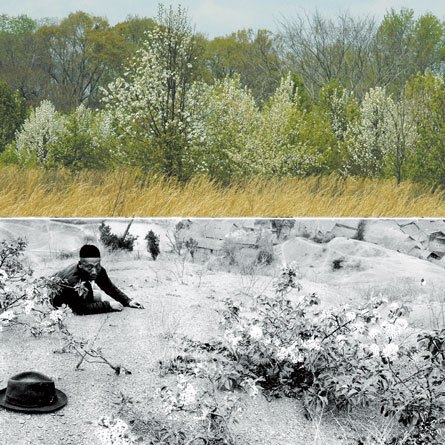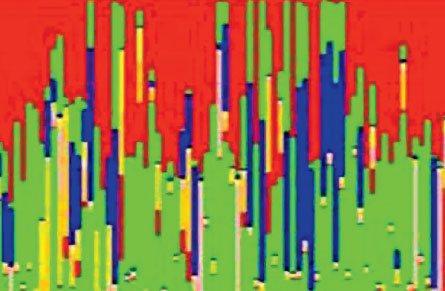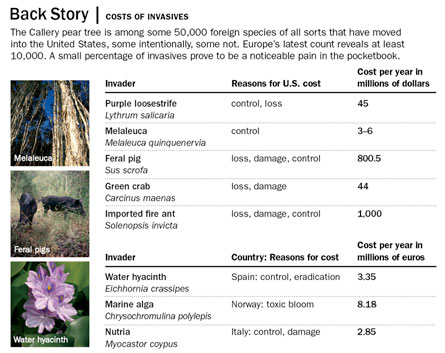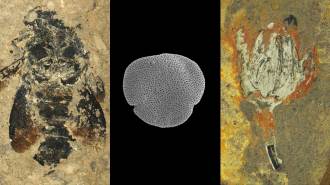As in other tales of nice kids gone wrong, the Callery pear tree’s troubles can be traced to a gang of new pals, a new genetic analysis suggests.
Imported from China, the Callery pear won U.S. hearts and yards coast to coast for its early spring clouds of white blossoms. The first ornamental variety of the species, named Bradford, went on sale in the early 1960s. It didn’t form fruit, so there would be no squishies on sidewalks or seeds escaping to sprout in native areas. Bradford’s success inspired the introduction of other named varieties.
Now many Callery pear varieties in the eastern United States bear bumper crops of hard, marble-sized fruits, says Theresa Culley of the University of Cincinnati. Animals distribute the seeds, and they sprout into dense thickets, sometimes with thorns, that can crowd out other plants.
Callery pears, Pyrus calleryana, have earned both a 2005 Urban Tree of the Year award (for the Chanticleer cultivar) and a place on the U.S. Fish & Wildlife Service list of highly invasive plants in the Mid-Atlantic.
What went wrong, Culley and Cincinnati colleague Nicole Hardiman report in the May Biological Invasions, was the proliferation of other cultivars introduced into the ornamental pear market after Bradford’s success. These later introductions added enough genetic variety to the gene pool for the trees to overcome their usual sterility and pollinate each other.
Sadly, it’s not just a few combinations of the varieties that can produce wilding seeds, Culley and Hardiman show. As Culley puts it, “It’s everything.”
Such cross-variety mixing puts the Callery pear on the latest list of plants and animals that have turned invasive after some form of hybridization, says Norm Ellstrand of the University of California, Riverside. The original list, published by Ellstrand and Kristina Schierenbeck in 2000, included 28 examples. Now there’s evidence for 35, Schierenbeck, with the Agricultural Research Service based at the University of Nevada, Reno and Ellstrand report, also in the May Biological Invasions.
The new pear study “does illustrate really nicely this issue of cultivated varieties and why we should be careful,” says conservation biologist Sarah Reichard of the University of Washington in Seattle. “We’re not just being arbitrary when we say, ‘No, your nice, supposedly safe, sterile cultivar really may not be.’”
Invasive species disrupt ecosystems and, to put the problem in more immediate terms, cost a lot of money, suggests work by David Pimentel of Cornell University. In his last tally, from 2005, unwelcome aliens, from feral pigs and starlings to water weeds and plant pathogens, cost the United States almost $120 billion a year.
In their native range, however, Callery pear trees are not a problem. “I’ve heard it’s actually hard to find this tree growing in the wild,” Culley says.
The U.S. government paid noted plant explorer Frank N. Meyer to search for trees in China in the 1910s and send back seed. Fire blight disease was rampant in U.S. pear orchards, so researchers culled through trees grown from the imported seed to select disease-resistant rootstocks. Then researchers looked through their many trees and selected one to clone and market as an ornamental — Bradford.
Early on, the Bradford ornamental didn’t fruit. Callery pears have a built-in safety lock against self-pollination. Called gametophytic self-incompatibility, this plant system sabotages (male) pollen that’s genetically similar to the female tissue of the plant. Researchers have identified a single gene for this system in the pear and in some other plants, Culley says. Each tree inherits a version of the gene called an allele from mom and another from dad. Forming pollen or egg cells will split the pair.
But whether a pollen grain inherits mom’s or dad’s allele, the tree recognizes the similarity should the grains land on its flowers. The similarity of the alleles triggers a mechanism that blocks the pollen from fertilizing the flower’s female parts. The grain starts growing a tube toward the egg, but the intervening tissue secretes an enzyme that destroys pollen RNA and shuts down the growth.
Those first Bradford trees were genetic clones of a single gorgeous tree. They didn’t fruit because, as far as their safety lock knew, all the other Bradford trees were still the same tree. As Bradford became popular though, nurseries started selling other varieties cloned from different, also remarkable, individuals among the Callery pear trees. Some populations of plants don’t have much variety in the incompatibility alleles, but the Callery pears have turned out to have plenty. And so trees received pollen that, instead of setting off any alarms, bore fruit.
In their study, Culley and Hardiman checked nine pieces of the highly variable, repetitious DNA called microsatellites to create genetic profiles of the popular Callery pear clones on the market. Looking at the mixed-and-matched microsatellites in wild trees let the researchers figure out parentage. The results pointed to a surprising amount of hybridizing going on in stands that have sprung up in Ohio, Tennessee and Maryland. Trees in these weedy patches are offspring of two cultivars, of a hybrid and a cultivar, or of two hybrids.
Experimental crosses of four common pear varieties likewise yielded fruit in almost all combinations.
Reichard reports that she has yet to hear of problem pears sprouting along the West Coast. Invasiveness varies by region, and she urges gardeners to keep an eye out for potential rogues. She recommends that both buyers and sellers of plants look up the St. Louis voluntary codes of conduct for guidance in keeping plants from falling into the wrong crowd.










